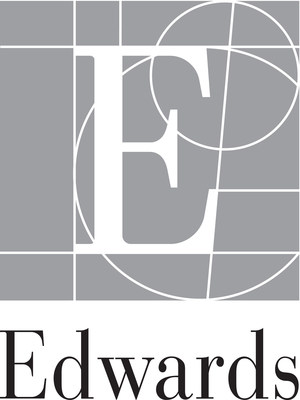CHICAGO, April 2, 2016 /PRNewswire/ -- Edwards Lifesciences Corporation (NYSE: EW), the global leader in patient-focused innovations for structural heart disease and critical care monitoring, today announced that the randomized PARTNER II Trial comparing the SAPIEN XT valve to surgery in intermediate-risk patients successfully achieved its primary endpoint at two years. The results of the study were presented as part of the late-breaking clinical trials at the American College of Cardiology's 65th Annual Scientific Session (ACC.16) in Chicago, and simultaneously published online in The New England Journal of Medicine.

The PARTNER II Trial is the first randomized clinical trial comparing outcomes of severe, symptomatic aortic stenosis patients who were at intermediate risk for open-heart surgery. The composite primary endpoint of the trial was all-cause mortality or disabling stroke at two years. The event rate was 19.3 percent for transcatheter aortic valve replacement (TAVR) with the SAPIEN XT valve, which was non-inferior, compared with 21.1 percent for surgery. For the 76 percent of SAPIEN XT patients receiving the transfemoral approach, the as-treated event rate was 16.3 percent, which was superior to surgery (p=0.04).
"The PARTNER II Trial is unique in size, distinctive in rigor of execution and exceptional in patient outcomes," said Craig Smith, M.D., chair, Department of Surgery, and surgeon-in-chief, NewYork-Presbyterian Hospital/Columbia University Medical Center. Smith is the co-principal investigator of the PARTNER II Trial. "In intermediate-risk patients, transcatheter and surgical valve replacements were similar with respect to the combination of mortality and disabling stroke. In this study, TAVR significantly shortened ICU and hospital stays, and, in patients who are candidates for transfemoral access, the SAPIEN XT valve may have additional clinical advantages."
The PARTNER II Trial randomized 2,032 patients at 57 centers in the United States and Canada between December 2011 and November 2013. Patients were stratified into the transfemoral or transapical/transaortic cohorts and then randomly assigned to undergo either transcatheter aortic valve replacement with the SAPIEN XT valve or surgical aortic valve replacement with any commercially available surgical valve. All patients were followed for at least two years. Strokes were assessed by a neurologist.
Data on intermediate-risk patients treated with the advanced SAPIEN 3 valve – with comparisons to surgical patients treated in the PARTNER II A Trial via a pre-specified propensity-score model – will be presented tomorrow during the joint ACC/TCT late-breaking clinical trials session. The SAPIEN XT valve and, more recently, the SAPIEN 3 valve, are approved in the United States for the treatment of high-risk patients with severe, symptomatic aortic stenosis; the valves are not approved for the treatment of intermediate-risk patients. The SAPIEN family of valves has been used in the treatment of more than 150,000 patients globally.
About Edwards Lifesciences
Edwards Lifesciences, based in Irvine, Calif., is the global leader in patient-focused medical innovations for structural heart disease, as well as critical care and surgical monitoring. Driven by a passion to help patients, the company collaborates with the world's leading clinicians and researchers to address unmet healthcare needs, working to improve patient outcomes and enhance lives. For more information, visit www.Edwards.com and follow us on Twitter @EdwardsLifesci.
This news release includes forward-looking statements within the meaning of Section 27A of the Securities Act of 1933 and Section 21E of the Securities Exchange Act of 1934. These forward-looking statements include, but are not limited to, Dr. Smith's statements and statements regarding expected product features, risks and benefits. Forward-looking statements are based on estimates and assumptions made by management of the company and are believed to be reasonable, though they are inherently uncertain and difficult to predict. Our forward-looking statements speak only as of the date on which they are made and we do not undertake any obligation to update any forward-looking statement to reflect events or circumstances after the date of the statement.
Forward-looking statements involve risks and uncertainties that could cause results to differ materially from those expressed or implied by the forward-looking statements based on a number of factors, including but not limited to, unanticipated outcomes following longer term clinical experience with the product; or unanticipated quality, manufacturing or regulatory delays or issues. These factors are detailed in the company's filings with the Securities and Exchange Commission including its Annual Report on Form 10-K for the year ended December 31, 2015. These filings, along with important safety information about our products, may be found at edwards.com.
Edwards, Edwards Lifesciences, the stylized E logo, Edwards SAPIEN, Edwards SAPIEN XT, Edwards SAPIEN 3, PARTNER, PARTNER II, SAPIEN, SAPIEN XT, and SAPIEN 3 are trademarks of Edwards Lifesciences Corporation. All other trademarks are the property of their respective owners.
Logo - http://photos.prnewswire.com/prnh/20140714/126903
To view the original version on PR Newswire, visit:http://www.prnewswire.com/news-releases/edwards-sapien-xt-valve-meets-primary-endpoint-in-partner-ii-trial-300245045.html
SOURCE Edwards Lifesciences Corporation
